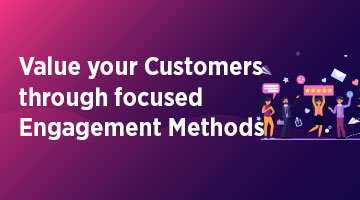Value your Customers through focused Engagement Methods

Introduction
Customer Engagement is the emotional connection between a customer and a store/brand/product. Highly engaged customers buy more, promote more, and demonstrate more loyalty. Providing a high-quality customer experience is an important component in your customer engagement strategy. But, how do you engage your customers and provide them a fulfilling experience when they visit your store? Well, this blog focuses on one such methods and how it helps the customers to develop a lasting impression towards your store.
Customer Segmentation and Product Recommendation
Both Customer Segmentation and Product Recommendations are used together to engage customers and provide them a user-specific engagement experience. Segmentation is simply a subset of your overall customer data. Creating a segment involves grouping clusters of customers with similar characteristics.
A segment can be based on demographic factors like age, gender, income, location, and actions such as purchasing behaviour. Some of the benefits of customer segmentation are;
- Customer Retention
- Enhanced Competitiveness
- Enhances Customer Relationship
- Improved Channel of Distribution
- Specific Product Recommendations
- Enhances Marketing
Product Recommendations are part of a personalization strategy wherein products are dynamically populated to a user based on data such as customer attributes or situational context—providing a personalised shopping experience. Product recommendations are especially valuable to organisations that have a very large, diverse product catalogue. The catalogue may be diverse due to a wide array of products (e.g. a Supermarket), or it may have a small number of product categories but lots of variety within feature sets of product offerings. Some of the benefits of product recommendation are;
- Provide Relevant Recommendations
- Engage Customers
- Boost Sales
- Maximise Revenues
- Maximise Customer Satisfaction
Let’s take an example of a Retail Analytics solution developed using Pentaho with R Integration, which uses this Customer Segmentation and Product Recommendation to drive Customer Engagement Experience.

The above image is a snapshot of the dashboard, which uses Customer Segmentation Technique in order to segment customers into three groups namely;
- Elite – Bulk Purchasers
- Loyal – Loyal Customers
- Wandering – Impulse Shoppers
These segments are obtained using multiple features such as Purchase Amount, Store Profit and Engagement for the said period. Also, moreover a scoring system is applied to the segments to filter out clients with high engagement and value. The outcome is provided as a Matrix (Heat Map) which highlights which segments of customers are focused on what Departments. The segmentation is done using a Machine Learning Algorithm.

Each Clusters has an inbuilt ‘Decision Control Chart’ and ‘Cluster Product Recommendations’ provided for each department. This SPC Chart serves an additional insight to understand the department level sales performance. Moreover, the Product Recommendations are provided at cluster level using Machine Learning Techniques. Recommendations are ordered based on multiple internal criteria in order to maximise the user experience and sales outcome.

Each Customer in each segment is scored using multiple features such as Quantity purchased, Sales amount, Store Profit and Store Engagement. The score helps to focus on most valuable customers in each segment in order to engage them differently.
Conclusion
Effective customer engagement deepens and strengthens the relationship with the customer. Starting from the journey of retention and acquisition, everything is crucial so that by studying your customers and adapting to their preferences you tend to gain more.
